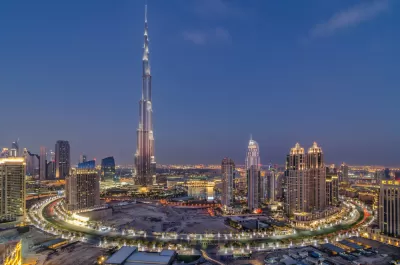A New York magazine article examines the idea of the mile-high skyscraper. Once imagined by Frank Lloyd Wright but impossible to build, the idea is not science fiction anymore.

Justin Davidson writes an in-depth article about the current limits of skyscraper technology and what it will take for the world's tallest towers to double in height and break the mile-high barrier.
Here Davidson introduces the idea of a mile-high skyscraper as impossible in the past and infeasible in the present:
"The mile-high skyscraper makes a little more sense to build now than it did when Frank Lloyd Wright designed one nearly 60 years ago. Wright imagined, on the fringes of Chicago, a habitable 528-story sundial called the Illinois. That idea wasn’t buildable then; its successor would still be risky, financially ruinous, slow to construct, and inefficient to operate. But that doesn’t mean a mile-high skyscraper won’t get done."
A common undercurrent of the article is an inherent warning: "A mile’s not science fiction. It’s not even an outer limit." But, writes Davidson, sometimes limits are a good thing: "Technological capacities have outpaced our judgment. We know we can do it, but we don’t know when not to do it."
The article includes technical detail about what makes the world's tallest buildings possible and some speculation about the challenges that the next generation of tallest towers will have to overcome in achieving new heights. Davidson also ties the conversation back to New York City—a place unlikely to ever have the "tallest anything" ever again but still not immune to the impacts of the skyward expansion of building technology.
FULL STORY: The Rise of the Mile-High Building

Alabama: Trump Terminates Settlements for Black Communities Harmed By Raw Sewage
Trump deemed the landmark civil rights agreement “illegal DEI and environmental justice policy.”

Planetizen Federal Action Tracker
A weekly monitor of how Trump’s orders and actions are impacting planners and planning in America.

The 120 Year Old Tiny Home Villages That Sheltered San Francisco’s Earthquake Refugees
More than a century ago, San Francisco mobilized to house thousands of residents displaced by the 1906 earthquake. Could their strategy offer a model for the present?

In Both Crashes and Crime, Public Transportation is Far Safer than Driving
Contrary to popular assumptions, public transportation has far lower crash and crime rates than automobile travel. For safer communities, improve and encourage transit travel.

Report: Zoning Reforms Should Complement Nashville’s Ambitious Transit Plan
Without reform, restrictive zoning codes will limit the impact of the city’s planned transit expansion and could exclude some of the residents who depend on transit the most.

Judge Orders Release of Frozen IRA, IIJA Funding
The decision is a victory for environmental groups who charged that freezing funds for critical infrastructure and disaster response programs caused “real and irreparable harm” to communities.
Urban Design for Planners 1: Software Tools
This six-course series explores essential urban design concepts using open source software and equips planners with the tools they need to participate fully in the urban design process.
Planning for Universal Design
Learn the tools for implementing Universal Design in planning regulations.
Clanton & Associates, Inc.
Jessamine County Fiscal Court
Institute for Housing and Urban Development Studies (IHS)
City of Grandview
Harvard GSD Executive Education
Toledo-Lucas County Plan Commissions
Salt Lake City
NYU Wagner Graduate School of Public Service


























